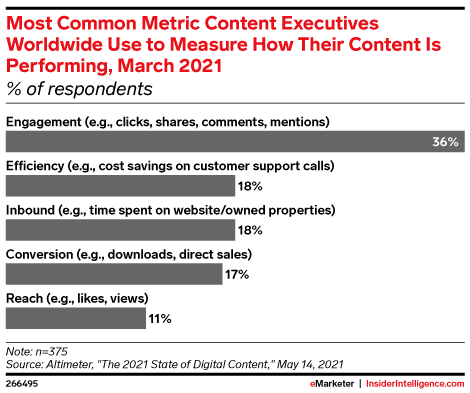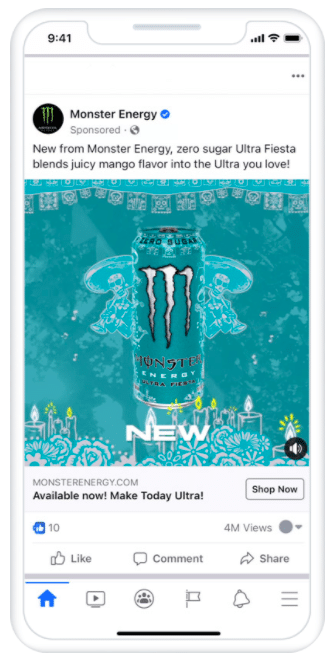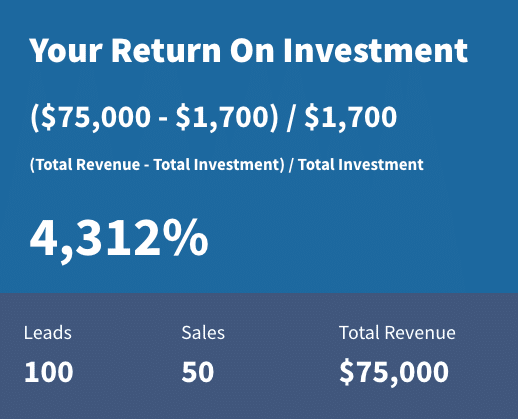Measuring social media ROI (return on investment) is a critical part of any social media manager’s job. It allows you to better understand the effectiveness of your work, demonstrate value to the organization, and refine your strategy over time to improve returns as you learn.
In this post, we’ll give you the tips and tools (including a free ROI calculator) you need to prove and improve your social ROI.
ROI stands for return on investment. Extend that to a social media ROI definition, and you get the return on investment from your social media activities and expenses.
Generally speaking, social media ROI is a measure of all social media actions that create value, divided by the investment you made to achieve those actions. After all the time, money, and resources put in — what’s the tangible return for your business?
Here’s a simple formula for how to calculate ROI for social media:
(Value achieved – investment made) / investment made X 100 = social media ROI
As long as your ROI is more than 0, your investments are making your business money. A negative ROI means that your investment was greater than the value it generated (a.k.a. you lost money).
Measuring social media ROI matters because it’s critical to building and refining your social marketing strategy. It shows you what’s working and what’s not—allowing you to shift resources and tactics to be more effective.
In the past, social media ROI has been a somewhat elusive concept, but that’s changing fast. More than 80 percent of respondents to the Hootsuite 2022 Social Trends survey said they are confident in quantifying social ROI. That’s a big jump from 68% last year.
Understanding and effectively communicating social ROI can also help you grow your social budget and expand your strategy. After all, it’s easier to justify spending money on strategies that provide more value than they cost.
Exactly how you calculate ROI depends on your organization’s objectives (brand awareness, revenue, customer satisfaction, etc.).
That’s why the formula above uses value, rather than revenue or profit, as the starting point.
For example, engagement is the most common metric (36%) content executives use to measure content performance. Conversions, at 17%, are the fourth-most-common metric.

Unlike conversions, engagement doesn’t have an obvious dollar value attached. But engagement clearly is valuable since brand awareness is the top content goal (35%). The value is in the brand awareness gained rather than in sales or revenue. The idea is that brand awareness will lead to real dollars and cents down the road.
Here’s how to measure ROI with social media.
Step 1: Calculate how much you spend on social media
Your social media costs might include:
- The cost of tools and platforms for managing social
- The budget allocated to social ad spends
- Content creation: In-house and external content creation costs, including working with creators and/or freelancers
- The ongoing costs for your social media team (salaries, training, etc.)
- Agencies and consultants, if you use them
Step 2: Define clear social objectives that connect to overall business goals
Clear social media objectives help define how social actions align with business and departmental goals.
Can you measure the ROI of your social media marketing without these goals?
Theoretically, you could, but real social ROI meaning is only achieved when you show how social returns connect to the bigger picture.
Think about various ways your social media investment might create value, like:
- Business conversions (such as lead generation, newsletter signups or sales)
- Brand awareness or sentiment
- Customer experience and loyalty
- Employee trust and job satisfaction
- Partner and supplier confidence
- Security and risk mitigation
More than half (55%) of respondents to the Hootsuite 2022 Social Trends survey said their social ads are completely integrated with other marketing activities. And the top goal for the brands most confident in measuring social ROI is expanding social’s impact onto other departments.
Step 3: Track metrics that align with your objectives
All social media metrics can tell you something about whether you’re achieving objectives and meeting your goals. But tracking the right metrics is important to fully understand your social ROI.
Metrics you can track to prove ROI include:
- Reach
- Audience engagement
- Site traffic
- Leads generated
- Sign-ups and conversions
- Revenue generated
When deciding what metrics to use, ask yourself how you will use the information. Consider:
- What kinds of things does the target audience do after exposure to a campaign?
- Does this metric align with my bigger business objectives?
- Does it help me make decisions (what to do more of, what to do less of, etc.)?
- Do I have the capacity to measure it effectively?
Check your metrics regularly. Ideally, you should get automated reports sent to your inbox, so you don’t have to remember to pull them yourself.
Tip: Measure your returns over an appropriate period based on your sales cycle. LinkedIn research found that 77% of marketers measured results within the first month of a campaign, even when they knew their sales cycle was three months or more. And only 4% measured ROI over more than six months.
LinkedIn also found that B2B sales cycles lengthened during the pandemic. Coordinate with your sales department to make sure you understand the appropriate timeframe for reporting results.
Step 4: Create an ROI report that shows the impact of social
Once you’ve got your data, share the results with the right stakeholders to show how social media marketing affects your organization’s bottom line. Here are some ways to make your report stand out:
- Use a template.
- Use plain language (avoid jargon and insider acronyms).
- Tie results back to the relevant business objectives.
- Use KPIs to track short-term progress.
- Articulate limitations and be clear about what you can (and can’t) measure.
1. Test and optimize
Are you running social ads? Experiment with different audience segments and ad formats.
There are countless things you can tweak to see which deliver the best results. As you report your social media marketing ROI, make it clear what you are learning and how those lessons provide value.
For example, Monster Energy’s standard approach to Facebook ads was to design a campaign around either reach or video views. For the launch of two new flavors of their Monster Ultra product, they tested combining reach and video view objectives in one campaign. They saw a 9.2% lift in sales. Based on this improved ROI, they decided to apply this ad strategy to all brands within the Monster portfolio.

Test your organic content, too. For example, Hootsuite ran a test to see if using “Link in Bio” in an Instagram caption decreased engagement and reach. The verdict? Nope: keeping the link in bio was just fine.
However, when Hootsuite ran a test on how links affect engagement on Twitter, they found posts with no links performed best.
Understanding which strategies to use for each social audience is a sure way to increase ROI. And it’s just another reason why you shouldn’t cross-post content (without adjusting it to the requirements and specs of each social network).
2. Gather intelligence and iterate
Social media is always changing. The content, strategies, and channels that connect with your audience today might not be effective tomorrow. You need to update and adapt your strategy over time.
Are customer needs and pain points changing? Has your business shifted priorities or resources? What new platforms and technologies are changing the way your audience is using social media?
Social listening is an important way to understand what’s happening in your market.
For example, look at the changing perceived value of various platforms within the last year. Facebook and Instagram both saw drops in effectiveness for achieving business goals, while TikTok, Snapchat, and Pinterest all saw impressive gains.

Remember that simply gathering this information itself brings value to your organization. Using the information to inform new iterations of your social strategy is an even better way to increase ROI over time.
3. Remember the big picture
Don’t chase short-term ROI to the point that you lose sight of what makes your brand valuable and unique.
Jumping on a trend just to get likes and comments doesn’t provide value if it annoys your audience or muddies your brand voice. It can even damage your brand in the long term.
Don’t forget that the big picture of social media ROI includes returns beyond the marketing department. Social media can be used to improve customer service and strengthen employee relationships—both worthwhile and valuable achievements that should be included when considering ROI.
Now that you know the theory behind measuring social ROI, here are some tools to make the process easier.
1. Social ROI calculator
We built this free tool to help you calculate the return on your social media investment for a specific paid or organic campaign. Plug in your numbers, hit the button, and you’ll get a simple, shareable ROI calculation based on lifetime customer value.

2. Hootsuite Social Advertising
Hootsuite Social Advertising is a cross-platform dashboard for managing paid and organic social campaigns together, so you can analyze and report on the ROI of ads and organic content in one place.
Seeing performance for organic and paid content together allows you to build a unified social strategy that maximizes your ad spend and in-house resources to quickly improve social ROI.
3. Google Analytics
This free analytics tool from Google is a must for tracking website traffic, conversions, and sign-ups from social media campaigns.
It allows you to go beyond one-off actions and track the value of your social campaigns over time by creating and tracking a conversion funnel.
Google Analytics has also made changes to its tracking systems to help digital marketers access campaign data without the use of first- or third-party cookies.

4. UTM parameters
Add these short text codes to the URLs you share on social media to track important data about website visitors and traffic sources.
Combined with analytics programs, UTM parameters give you a detailed picture of your social media success, from a high level (which networks are performing best) down to the granular details (which post drove the most traffic to a specific page).
You can add UTM parameters to your links manually or using link settings in Hootsuite.
5. Facebook Pixel and Conversions API
The Facebook Pixel is a piece of code for your website that allows you to track conversions from Facebook ads—from leads to sales. That way you can see the full value each Facebook ad creates, rather than just clicks or immediate sales.
It also helps you improve social ROI by ensuring you show your Facebook and Instagram ads to the audiences most likely to respond to your content, including through remarketing.
The effectiveness of the Facebook Pixel has decreased with the implementation of iOS14.5 and ongoing changes to the use of both first- and third-party cookies. To help mitigate these changes, add Conversions API, which collects information directly from your servers.

Learn more about the Facebook pixel and Conversions API in our detailed guides.
6. Hootsuite Impact
Hootsuite Impact provides social media marketing ROI measurement across paid, owned, and earned social channels.
Impact connects to your existing analytics systems so you can integrate social data with the rest of your business metrics. It makes producing reports easy, and delivers plain-language recommendations to optimize your social strategy (and thereby improve social ROI).
Use Hootsuite Impact and get plain-language reports of your social data to see exactly what’s driving results for your business—and where you can boost your social media ROI.
Prove and improve social ROI with Hootsuite Impact. Track conversions, conversations, and performance across all channels.